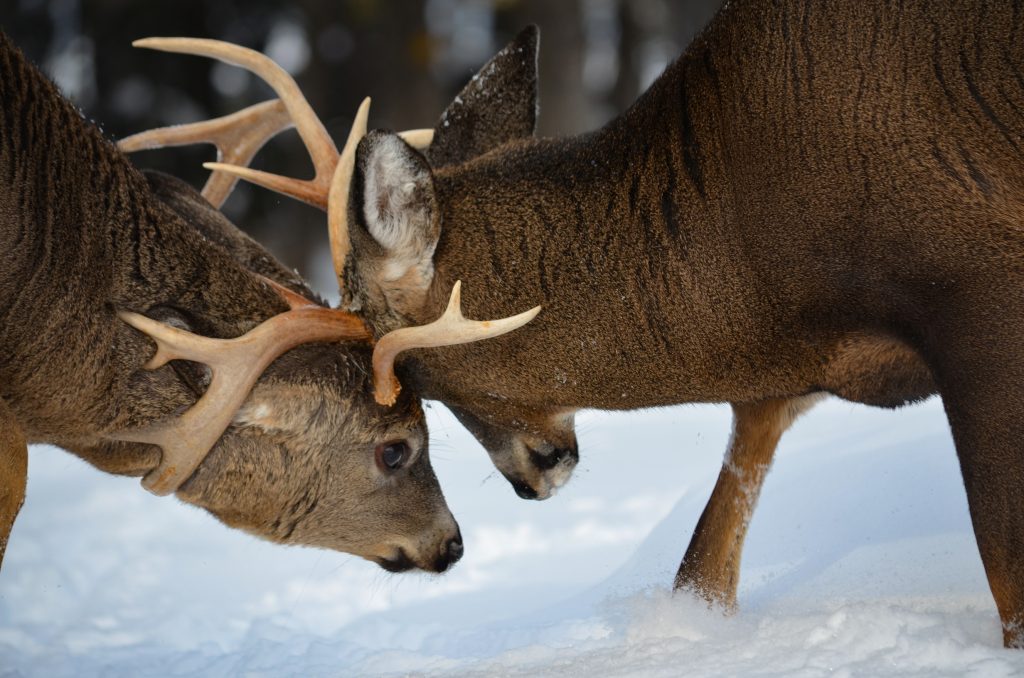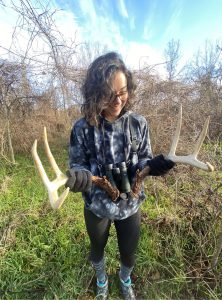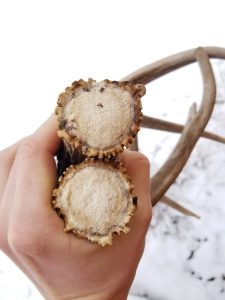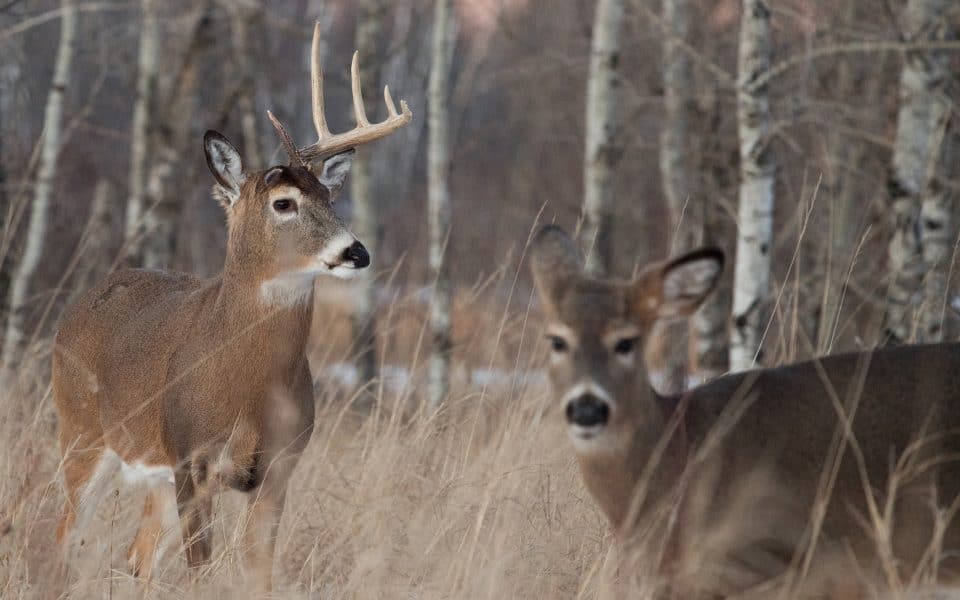Deer antlers are arguably the most fascinating part of deer anatomy, creating an inexplicable allure impossible to explain. Yet anyone who has seen an impressive antlered buck can relate. The reason we obsess over antlers could be that there is nothing else like them in the animal world, each one is unique, and their annual cycle of life is a physiological feat of its own. So, why do whitetail bucks shed their antlers?
As fall gives way to winter, many of us will be taking to the woods for our annual hikes looking for shed antlers. However, to appreciate the sheds you may find, one must look past the points and burrs at the animal growing these interesting treasures to ask “how” and “why.”
Antler shedding puts the period on the end of an antler’s useful life and begins day one of next year’s antler. It is becoming ever more popular to search for shed antlers and there’s tons of information available to teach a new shed hunter how to find antlers. What you may not know is answers to fun questions like, “why do deer have antlers and not horns?”, “why did this buck shed so early?”, or “what actually makes an antler shed?” Let’s looks at the answers to these questions and more.
 Why Grow Antlers?
Why Grow Antlers?
Antlers differ from horns in several physical traits. First, antlers are composed of bone; whereas horns contain a living bone core surrounded by a keratin sheath (keratin is the same material that makes up fingernails). With the exception of pronghorn in the Western United States, horned animals do not shed their horns, but antlers are shed and regrown every year. Additionally, antlers contain forks, where most horns are not forked. Finally, horns grow from the base, with the oldest material at the horn tip, but antlers grow at the tips when in velvet.
Antler growth occurs from late spring through summer. A deer’s body is programmed to pull minerals out of its skeleton to be used for antler development – meaning that every summer a buck is in a temporary state of osteoporosis. Then, outside of the antler growth season, these missing mineral deposits are restored to the skeleton. This is necessary because a deer cannot absorb minerals fast enough through its digestive system to supply the needs of antler growth, the fastest growing tissue of any animal.
This energetically demanding process of annually growing a few pounds of pure bone on one’s head, only to drop it after several months of use doesn’t sound like the most efficient use of energy. In the animal world, energy is the difference between life and death. An animal must take in more energy than it expends, or it cannot live, but more importantly, it cannot reproduce. So, this begs the question, why do deer grow antlers every year, wouldn’t permanent horns be a better energy investment?
The leading hypothesis on why deer have antlers, instead of horns, is that antlers are a more sensitive indicator of a buck’s health than horns would be. Let me explain – in the most basic biological sense, it is imperative that a doe breeds with a healthy, well adapted buck. This increases the likelihood that her offspring will thrive and thus replace her, propagating her species. Antlers serve to this end through a couple of mechanisms. Larger antlers play a role in determining which buck wins a sparring match, which can affect buck survival, dominance hierarchy, and ultimately breeding opportunities. Additionally, recent research from the Mississippi State Deer Lab indicates that if a doe is given the opportunity, she will select to breed with a larger over a smaller antlered buck.
Horn size could serve deer in the same way for sparring and mate selection, as it does in other animals, but antlers are a more sensitive cue. For instance, if a buck suffers several bone fractures through an injury, his body will devote much of its energy to mending his injured skeleton, diverting energy from antler growth. When a buck is in survival mode like this, his growing antlers will be much smaller than if he were in tiptop shape with extra skeletal resources to devote to antler growth.
On the other hand, if through a sparring match he breaks off one of his main beams, he will replace it the next season with completely new antlers. Horns do not regrow, so if deer had horns this buck would be out of luck the rest of his life. In both examples, antlers are better than horns for indicating a buck’s fitness, a sickly buck will have smaller antlers and a healthy buck that broke his antler will grow a new one, both bucks having antler sizes that are accurate indications of their fitness.

J Bonin
The bottom line is that antlers serve a very specific purpose in a buck’s life. They are more than just a crown, enticing hunters, they are a buck’s sparring weapons, his defense against predators, and how he “struts his stuff.” Antlers are imperative to deer reproduction.
The Antler Regulator
 All parts of the antler growth and shedding process are regulated by testosterone. Testosterone levels rising in late summer trigger the mineralization of antlers and later cue the drying and shedding of velvet. Testosterone levels peak during the rut, leading to swollen necks, aggressive behavior, and a focus shift from eating to breeding. At the end of the rut, bucks have lost a lot of weight, and soon their attention shifts back to a feeding routine. As their testosterone levels drop after the rut, the shedding process is triggered.
All parts of the antler growth and shedding process are regulated by testosterone. Testosterone levels rising in late summer trigger the mineralization of antlers and later cue the drying and shedding of velvet. Testosterone levels peak during the rut, leading to swollen necks, aggressive behavior, and a focus shift from eating to breeding. At the end of the rut, bucks have lost a lot of weight, and soon their attention shifts back to a feeding routine. As their testosterone levels drop after the rut, the shedding process is triggered.
While testosterone is the hormone that triggers these milestones in a buck’s antler and breeding cycle, there are other factors that regulate testosterone levels. The main regulator of the whitetail’s year is the sun. Photoperiod, or day length, is the environmental cue that tells a buck’s body to produce more or less testosterone and tells a doe’s body when it’s time to breed. Thus, the ultimate cue that triggers antler shedding is day length.
However, there are other external factors that can affect testosterone levels and thus antler shedding. Late breeding opportunities, for instance, will lead to higher maintained testosterone levels. “Late breeding does” is usually the result of an unsuccessful egg implantation after the first breeding attempt, a sexually maturing doe fawn, or occasionally a doe that was missed during the rut. If there are still breeding opportunities, a healthy buck will maintain heightened testosterone levels to breed available does.
On the other hand, an unhealthy or wounded buck may experience sudden declines in testosterone levels. This often happens when a buck endures a vehicle accident, nonfatal shot, or is injured while sparring. In these scenarios, a buck’s body goes into survival mode and suddenly is no longer focused on breeding, but rather on conserving as many resources as possible for survival. When a buck is physically stressed like this, he experiences a sudden dip in testosterone levels, and this triggers antler shedding. So, if you’ve ever seen that a buck shed antlers in November or December, there is a reason for it, and he is likely not doing well.
What Makes Antlers Drop?
We know that testosterone levels and ultimately photoperiod are responsible for triggering antler shedding, but just how are antlers shed? The answer to this is a little complex and just another one of the special behaviors that make antlers unique.
 On a buck’s skull there are two protrusions of bone, one above each eye. As most gamekeepers know, these protrusions are called “pedicles” and are the connector between a buck’s antlers and his skull. Pedicles are a permanent part of a buck’s skeletal system, but they do grow in diameter over a buck’s life. At the base of each antler is the antler burr, this burr effectively functions as a protective shield at the base of each antler protecting the skin edge where it meets the pedicle.
On a buck’s skull there are two protrusions of bone, one above each eye. As most gamekeepers know, these protrusions are called “pedicles” and are the connector between a buck’s antlers and his skull. Pedicles are a permanent part of a buck’s skeletal system, but they do grow in diameter over a buck’s life. At the base of each antler is the antler burr, this burr effectively functions as a protective shield at the base of each antler protecting the skin edge where it meets the pedicle.
“Osteoclasts” are a specialized type of cell that are accumulated at the base of the antler between the burr and the pedicle. An osteoclast’s function is bone absorption. As testosterone levels drop, the osteoclasts are activated and begin actively breaking down the bone interface between the pedicle and antler, known as the “abscission line.” The abscission line becomes weaker until finally, it can no longer support the weight of the antler and it pops off. The result is an antler shed with tiny pits across the base where the abscission line developed. Afterward, a scab will form across the open, bloody pedicle and the next year’s antler begins to grow.
Incredible Bones
There is no doubt that antlers deserve all the hype they are attributed by hunters and non-hunters alike. Seeing a buck or better yet finding his shed antlers should be cause to appreciate the complicated process that produces these incredible trophies. Good luck in the field as you search for shed antlers and remember the story of how that antler grew and shed!
Moriah Boggess is a Deer Biologist with North Carolina Wildlife Resources Commission


 Why Grow Antlers?
Why Grow Antlers?



